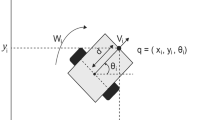Abstract
This paper aims at attaining one-leader & two-followers (1L-2F) formation control of multi-nonholonomic mobile robot (multi-NMR) systems subject to uncertainties and, at the same time, achieves trajectory-tracking of the leader NMR. To begin, the tracking error between the leader and a virtual reference robot is defined. Then, the extension to a leader-follower formation control structure is utilized to define the formation error (i.e., separation and orientation errors) between the leader and the followers. It has been proven that fuzzy sliding-mode tracking control (FSMTC) and backstepping formation control (BFC) can improve performance and stability when the overall closed-loop system is subject to uncertainties. Therefore, FSMTC and BFC are used for trajectory tracking of the leader NMR and formation control for two followers with respect to the leader, respectively. The stability of the closed-loop multi-NMR systems, i.e., trajectory tracking and formation control, is demonstrated through Lyapunov stability criteria. Finally, to validate the theoretical developments, computer simulations are conducted which prove the effectiveness, efficiency and robustness of the proposed scheme.
Similar content being viewed by others
References
Kwon, J.-W., Chwa, D.: Hierarchical formation control based on a vector field method for wheeled mobile robots. IEEE Trans. Robot 28(6), 1335–1345 (2012)
Hernandez-Martinez, E.G., Aranda-Bricaire, E.: Multi-agent formation control with collision avoidance based on discontinuous vector fields. In: Proceedings of the IEEE International Conference Industrial Electronics, pp 2283–2288 (2009)
Hsu, H.C.-H., Liu, A.: Multiagent-based multi-team formation control for mobile robots. J. of Intelligent Robotic Systems 42(4), 337–360 (2005)
Balch, T., Arkin, R.C.: Behavior-based formation control for multirobot teams. IEEE Trans. Robot. Autom. 14(6), 926–939 (1998)
Rezaee, H., Abdollahi, F.: A decentralized cooperative control scheme with obstacle avoidance for a team of mobile robots. IEEE Trans. Ind. Electron. 61(1), 347–354 (2014)
Zhang, Q., Lapierre, L., Xiang, X.: Distributed control of coordinated path tracking for networked nonholonomic mobile vehicles. IEEE Trans. Ind. Informatics 9(1), 472–484 (2013)
Vela, P., Betser, A., Malcolm, J., Tannenbaum, A.: Vision-based range regulation of a leader-follower formation. IEEE Trans. Contr. Syst. Technol. 17(2), 442–448 (2009)
Gu, D., Yang, E.: Fuzzy policy reinforcement learning in cooperative multi-robot systems. J. of Intelligent Robotic Systems 48(1), 7–22 (2007)
Mehrjerdi, H., Saad, M., Ghommam, J.: Hierarchical fuzzy cooperative control and path following for a team of mobile robots. IEEE/ASME Trans. Mechatronics 16(5), 907–917 (2011)
Dierks, T., Jagannathan, S.: Neural network output feedback control of robot formation. IEEE Trans. Syst., Man and Cybern. 40(2), 383–399 (2010)
Dierks, T., Brenner, B., Jagannathan, S.: Neural network-based optimal control of mobile robot formations with reduced information exchange. IEEE Trans. Contr. Syst. Technol. 21(4), 1407–1415 (2013)
Defoort, M., Floquet, T., Kokosy, A., Perruquetti, W.: Sliding-mode formation control for cooperative autonomous mobile robots. IEEE Trans. Ind. Electron. 55(11), 3944–3953 (2010)
Chang, Y.H., Chang, C.W., Chen, C.L., Tao, C.W.: Fuzzy sliding-mode formation control for multirobot systems: Design and implementation. IEEE Trans. Syst., Man and Cybern. 42(2), 444–457 (2012)
Mariottini, G.L., Morbidi, F., Prattichizzo, D., Vander Valk, N., Michael, N., Pappas, G., Daniilidis, K.: Vision-Based localization for leader-follower formation control. IEEE Trans. Robot. 25(6), 1431–1438 (2009)
Ranjbar-Sahraei, B., Shabaninia, F., Nemati, A., Stan, S.: A novel robust decentralized adaptive fuzzy control for swarm formation of multiagent. IEEE Trans. Ind. Electron. 59(8), 3124–3134 (2012)
Fierro, R., Lewis, F.L.: Control of a nonholonomic mobile robot using neural networks. IEEE Trans. Neural Networks 9(4), 389–400 (1998)
Dierks, T., Jagannathan, S.: Neural network control of mobile robot formations using rise feedback. IEEE Trans. Syst., Man and Cybern. 39(2), 332–347 (2009)
Egerstedt, M., Hu, X., Stotsky, A.: Control of mobile platforms using a virtual vehicle approach. IEEE Trans. Automat. Contr. 46(11), 1777–1782 (2010)
Kanayama, Y., Kimura, Y., Miyazaki, F., Noguchi, T.: A stable tracking control method for an autonomous mobile robot. In: Proceedings of the IEEE International Conference on Robotics and Automation, pp 384–389 (1990)
Khalil, H.K.: Nonlinear Systems, 2nd edn. Prentice-Hall, Upper Saddle River, NJ 07458 (1996)
Hwang, C.L., Chang, L.J., Yu, Y.S.: Network-based fuzzy decentralized sliding-mode control for car-like mobile robots. IEEE Trans. Ind. Electron. 54(1), 574–585 (2007)
Author information
Authors and Affiliations
Corresponding author
Rights and permissions
About this article
Cite this article
Wu, HM., Karkoub, M. & Hwang, CL. Mixed Fuzzy Sliding-Mode Tracking with Backstepping Formation Control for Multi-Nonholonomic Mobile Robots Subject to Uncertainties. J Intell Robot Syst 79, 73–86 (2015). https://doi.org/10.1007/s10846-014-0131-9
Received:
Accepted:
Published:
Issue Date:
DOI: https://doi.org/10.1007/s10846-014-0131-9
Keywords
- Leader-follower formation control
- Multi-nonholonomic mobile robots
- Virtual reference robot
- Fuzzy slidingf-mode tracking control
- Backstepping formation control
- Lyapunov stability criteria




